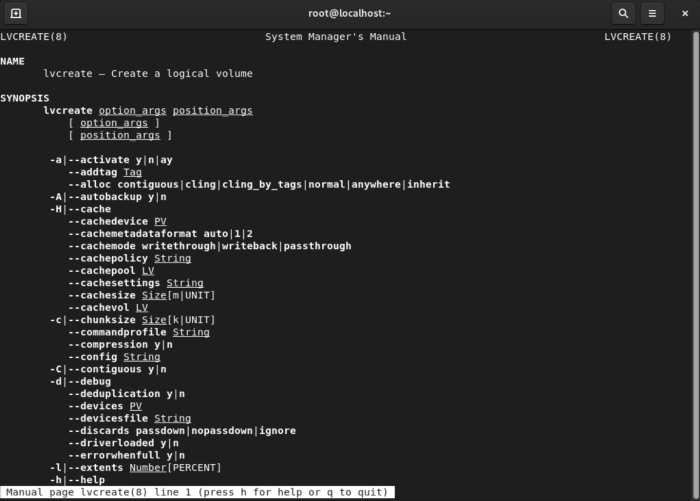Finding Help in Linux
Lost in the terminal? Don't worry — Linux has your back with tons of built-in help. Whether you're just poking around or knee-deep in shell scripts, there's always a way to get unstuck. Let's walk through some handy ways to find help (and maybe a few hidden gems) right from your command line.
1. Manual Pages (man)
The classic move: check the manual! Linux comes loaded with "man pages" — detailed guides for almost every command and utility. To peek at the manual for a command, just type:
Curious about lvcreate? Try:
Results in:

You'll get a full rundown: what the command does, all its options, and some usage notes. It's like having a wise old wizard explain things (with extra beard).
Navigating the Manual Pages
- Search: Hit
/, type your keyword, and press Enter to jump to what you need. - Quit: Press
qwhen you're done (no need to be polite). - Scroll: Use the arrow keys or spacebar to move around.
Rebuilding the Manual Pages
Just installed Linux and man seems a bit empty? Sometimes the manual
page database needs a refresh. You can rebuild it with:
This updates the index so you get the latest docs. Handy if you've just added new packages or tools.
Manual Page Sections (A Quick Map)
Man pages are split into sections — think of them as chapters in a choose-your-own-adventure book:
- 1: User commands (the stuff you'll run most often)
- 2: System calls (how programs talk to the kernel)
- 3: Library calls (functions in libraries)
- 4: Special files (usually in
/dev) - 5: File formats and conventions (like
/etc/passwd) - 6: Games (yes, really)
- 7: Miscellaneous (macros, conventions, and oddities)
- 8: System admin commands (for the brave and root users)
- 9: Kernel routines (advanced stuff)
If you're just starting out, sections 1 and 8 are your best friends. Sections 5 and 7 are great for file formats and conventions.
But what if you don’t even know the command’s name yet? That’s where searching comes in.
2. Fuzzy Searching For Commands
Can't remember the exact command? No problem — Linux lets you search by keyword:
man -k <keyword>: Lists all commands related to your keyword.apropos <keyword>: Does the same thing, just with a different name.
For example, to find anything about networking:
Or:
Want to narrow it down even more? Pipe it through grep:
It's like asking Linux, "Hey, what do you know about this?" — and getting a list of everything it can find.
Once you’ve found the right command, though, you don’t always need the
full manual. Sometimes you just want a quick hint — enter --help.
3. Quick Hints with the --help Option
Almost every Linux command has a built-in help option you can summon with
--help. Think of it as the command whispering, “Here’s what I can do” —
without dragging you through the whole manual.
Try this with ls:
You’ll get a concise list of options, their meanings, and sometimes even a few examples. It’s perfect when you just need a quick refresher.
A couple of tips:
-
Single vs double dash: Some older commands use
-hinstead of--help. If--helpdoesn’t work, try-h. -
Too much text? Pipe it into
lessto make it scrollable: -
Not universal: A few grumpy old commands (looking at you,
vi) don’t play by these rules — in those cases, man is still your friend.
This is usually the fastest way to jog your memory on a command’s
options. For deeper dives or background details, head back to the man
pages.
With these tricks — man pages for the deep dives, fuzzy searching
when you can’t quite remember the name, and the handy --help flag for a
quick refresher — you’ll never be stuck for long.
The Linux help system is deep, but friendly once you know where to look. Keep exploring, keep asking questions, and remember: even the pros check the manual (sometimes twice).